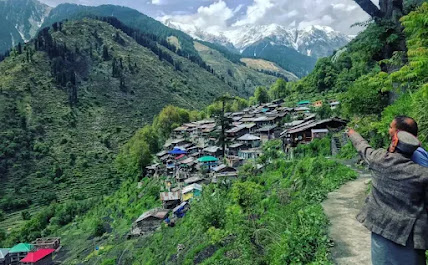KOPAI RIVER:
Kopai River is a well-known tourist destination to visit with family and friends and is located at Goalpara, west Bengal's Bolpur Birbhum. Its calm atmosphere refreshes you and relieves your headache.
KHOYAI:
Khoyai is the actual place where the re-known khoyai hat, is used to be held, people from various places come here to visit this, they find some attractive handmade things like jewelry home decor, etc. This place has surrounded by eucalyptus trees.
Lalbandh:Lalbandh is the hidden gem of Bolpur, Shantiniketan. There is a lake nearby, and on its bank, there is a border-style area where people may sit that gets rather crowded in the summer. After dusk, a cool breeze blows from the opposite side of the lake, which is a wonderful place to escape the summer's humidity.
MT.KANCHENJUNGA :
Kangchenjunga is the third-highest mountain in the world. Its summit lies at 8,586m (28,169 ft). The 16 peaks in the Himalayas are higher than 7,000 meters (23,000 feet), and the Kangchenjunga Himal region includes both Nepal and India.
KECHAPORI lAKE:
In the West Sikkim district of the Northeastern Indian state of Sikkim, Khecheopalri Lake is a lake close to Khecheopalri hamlet. It was formerly known as Kha-Chot-Palri (meaning the heaven of Padmasambhava). It is situated 147 kilometers (91 mi) west of Gangtok.[1]
CHERRY BLOSSOM:
The flower of various trees in the genus Prunus or Prunus subgenus is named a cherry blossom, often known as a Japanese cherry or sakura. Cerasus. They are a widespread species in East Asia, particularly in Japan, China, Korea, and Korea. It has also regarded as Japan's national flower.
MOUNTAINS & SKY:
The Himalayas encircle Sikkim's limits on its north, east, and west sides. Sikkim is divided from Tibet in the northeast and Bhutan in the southeast by the Chola range, Nepal in the west by the Singelila range, and Tibet in the north by the Greater Himalayan range.
RESIDENCY BUILDING BETWEEN VALLEYS:
When travelers look out from the balcony of their hotel rooms into valleys bathed in the morning sun and surrounded by buildings housing tourists, they experience an epic mood. It is an undoubtedly lovely feeling to see the sunrise amid the lush valleys.
NAMCHI:
In the Indian state of Sikkim, Namchi serves as a city and the governing body of the Namchi district. In Sikkimese, the name Namchi translates to Sky '(Nam) and' High '(Chi)'.The location of Namchi is 27.17°N 88.35°E. It is typically 1,315 meters (4,314 feet) above sea level.
Namchi is located 1,675 meters (5500 ft) above sea level. Its location is 78 kilometers (48 miles) from the state capital Gangtok and 100 kilometers (62 miles) from Siliguri, the town with the closest rail station and airport. Between Melli and Jorethang, the location of Namchi off the beaten path.
SEVEN SISTERS WATERFALL(SIKKIM):
Seven Sister is a well-known waterfall located on the Gangtok- Lachung Highway, around 32 kilometers away from Gangtok. The seven separate waterfalls, which are harmoniously positioned sideways on a broad, craggy cliff, appear distinct when viewed from a distance, as the name implies. After a shower, the falls in Gangtok spring to life and give an impressive spectacle, making it a must-see location.
YAMTHANG VALLEY:
The Yumthang Valley or Sikkim Valley of Flowers sanctuary is a nature sanctuary with a river, hot springs, yaks, and grazing pasture on rolling meadows surrounded by the Himalayan mountains in the North Sikkim district of Sikkim state in India. It is at an elevation of 3,564 meters (11,693 ft) above msl at a distance of 150 kilometers (93 mi) from the state capital Gangtok. It is popularly known as the 'Valley of Flowers and is home to the Shingba Rhododendron Sanctuary, which has over twenty-four species of the rhododendron, the state flower. The flowering season is from late February to mid-June when countless flowers bloom to carpet the valley in multicolored hues of the rainbow.
KANGRA VALLEY(HIMACHAL PRADESH): Kangra, one of Himachal Pradesh's most well-known valleys, is a stunningly gorgeous valley and a must-visit place among tourists. It is home to the 600-year-old Masroor Rock Cut Temple in addition to its mountains.
KANGRA VALLEY RAILWAY:The narrow-gauge Kangra Railway is not your pretty hill-station railway, carrying vacationers or newlyweds in first-class carriages, unlike the Shimla or Ooty "toy trains," It's a blessing for its local passengers, generally, villagers who utilize the service since it's less expensive than the bus, who travel 164 km from Pathankot to Jogindernagar for the princely sum of Rs 27. Finding a seat is not sure, but breathtaking vistas are. The Kangra Railway, which was constructed in the 1920s to move heavy machinery for the construction of the Hydro Electric Power House at Joginder Nagar, is today a working museum of early 20th-century technology and is the safest, most dependable and least expensive method of transportation for the residents.
KINNAUR VALLEY(HIMACHAL PRADESH):
One of the twelve administrative districts of the northern Indian state of Himachal Pradesh is Kinnaur. Kinnaur, it is situated in the northeastern part of Himachal Pradesh and borders Tibet to the east, is roughly 235 kilometers (146 miles) from the state capital, Shimla. The Baspa, Satluj, and Spiti valleys, as well as their rivers, are enclosed by the three high mountain ranges of Zanskar and the Himalayas.

SOLANG VALLEY (HIMACHAL PRADESH):
The phrases Solang (a nearby village) and Nallah (a water stream) are combined to form the name Solang Valley. It is a side valley at the top of the Kullu Valley in Himachal Pradesh, India, 14 km to the northwest of the tourist destination Manali, and is renowned for its summer and winter sports conditions. The most frequently provided sports include zorbing, skating, paragliding, and parachute jumping.
SPITI VALLEY (HIMACHAL PRADESH):
The high-altitude Spiti region of the Himalayas has found in the northeastern portion of the Himachal Pradesh state in northern India; it is pronounced as "Piti" in Bhoti. The word "Spiti" refers to the region that lies between Tibet and India and means "The Middle Land". Spiti is made up primarily of the Spiti River Valley and the valleys of other rivers that flow into it. The Pin valley and the Lingti valley are two notable side valleys in Spiti. Tibet borders Spiti on the east, Ladakh on the north, Kullu on the south, and Kinnaur on the southeast. Lahaul borders Spiti on the west, southwest, and southwest. Spiti has a chilly desert climate. The valley and the areas around it are some of the least populated.
DARJEELING:
The Tibetan terms "dorje," which means a thunderbolt (and was originally Indra's sceptre), and "ling," which means a location or region, are the source of the name "Darjeeling," which means "the land of the thunderbolt." It would be proper to examine Darjeeling's history before 1835, a landmark year in the region's history. Darjeeling was formerly a part of Sikkim then, briefly, Nepal until being purchased by the East India Co. in 1835. However, neither the histories of Sikkim nor Nepal include any information on their early histories.
TEA GARDEN OF DARJEELING:
Darjeeling tea is a kind of Camellia sinensis that is cultivated and processed in the West Bengal, India, districts of Darjeeling or Kalimpong. Since 2004, items grown on specific estates in Darjeeling and Kalimpong have been referred to as Darjeeling tea as a geographical designation. Although some estates have increased their product offers to include leaves suited for brewing green, white, and oolong teas, the tea leaves are processed as black tea.



.jpg)

















Comments
Post a Comment